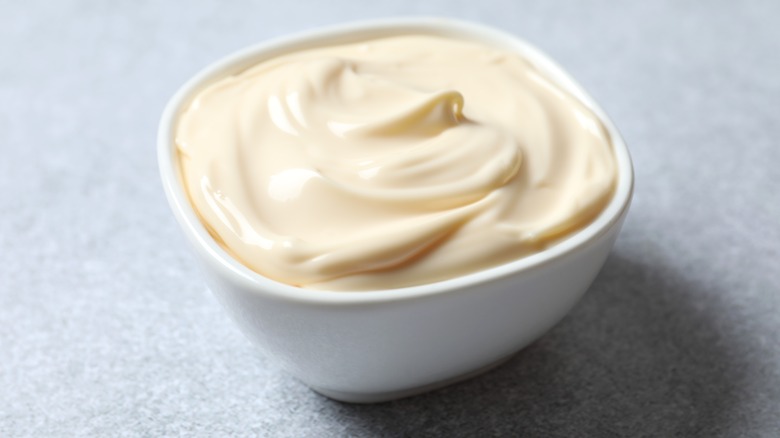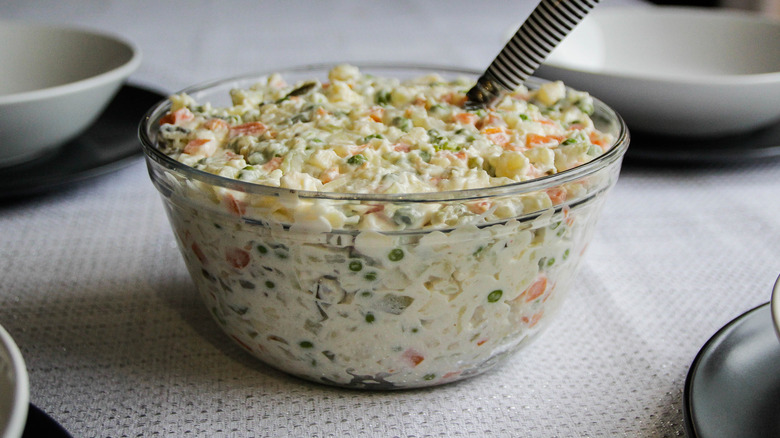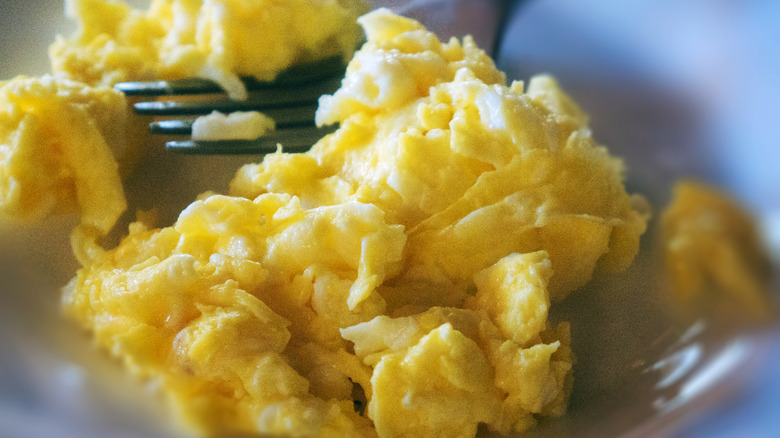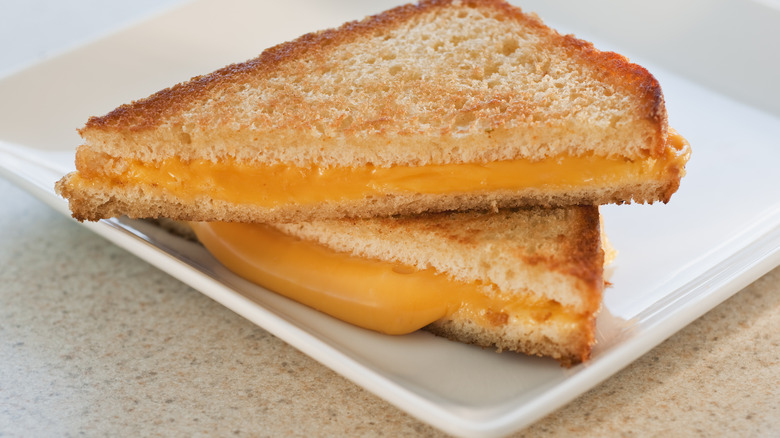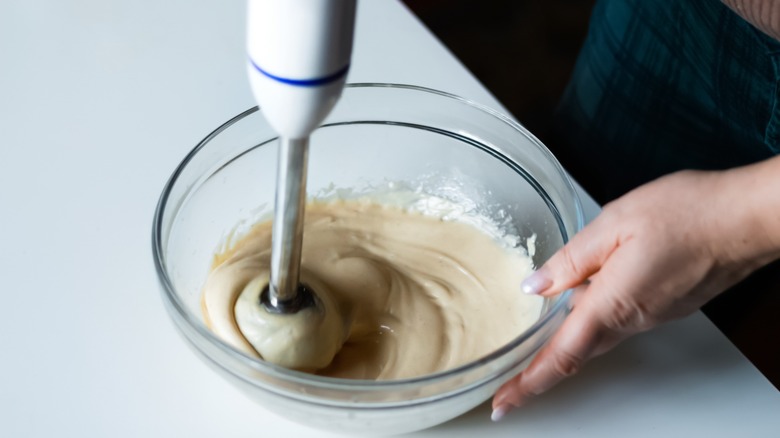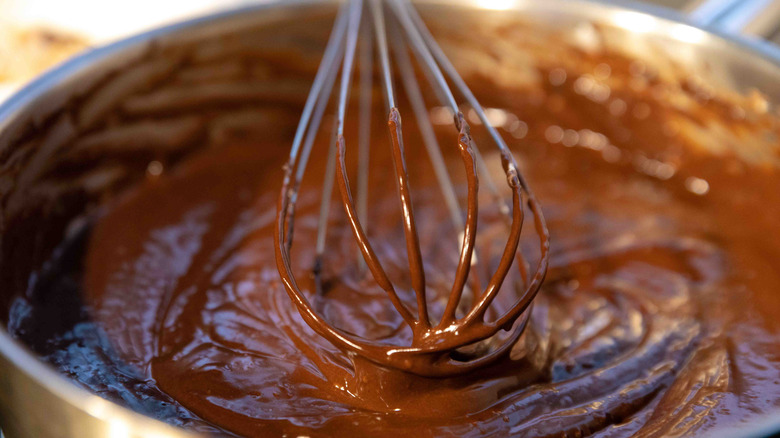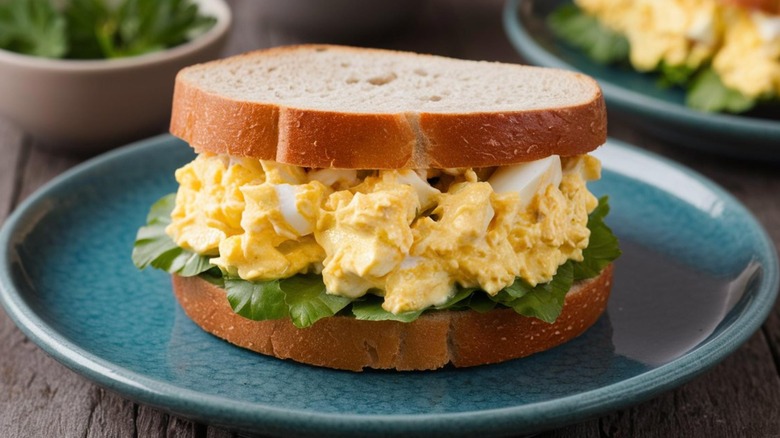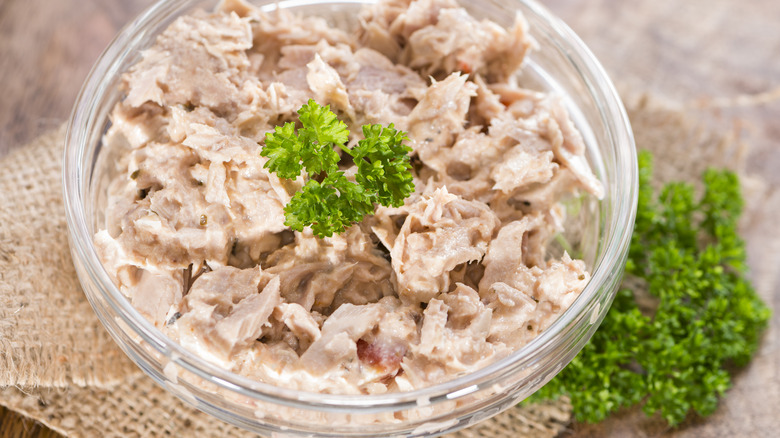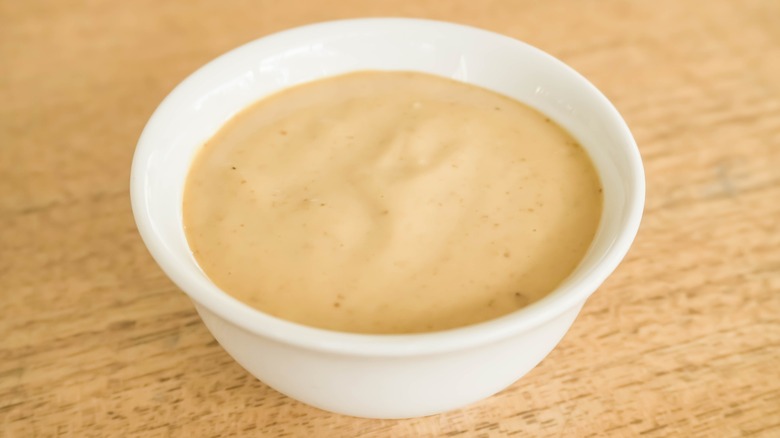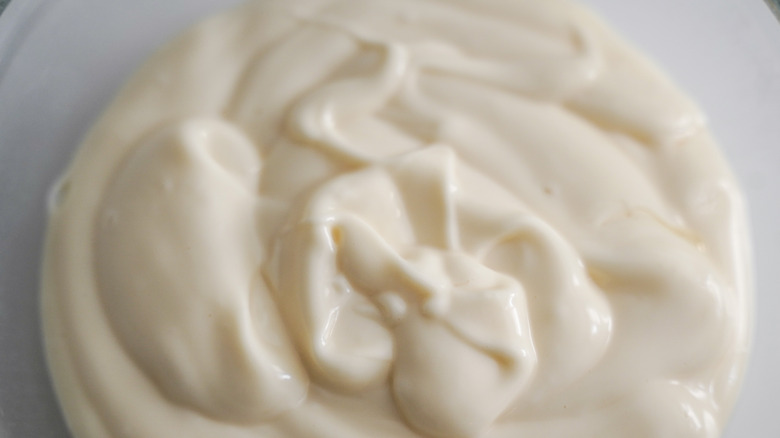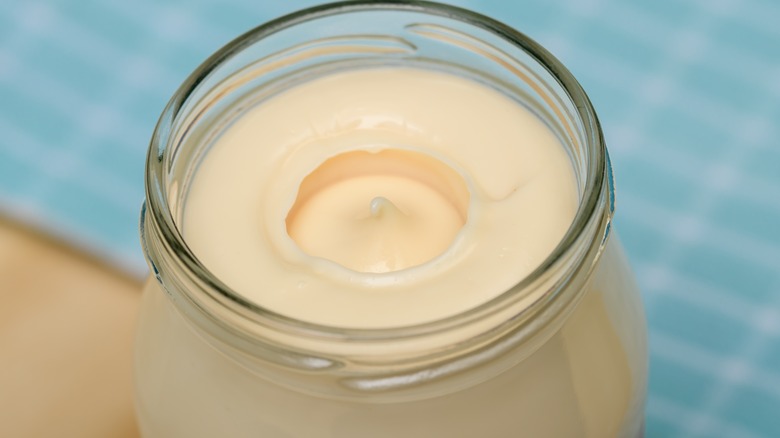Mayonnaise Mistakes You Need To Avoid Making
Mayonnaise is both polarizing and mundane, one of the most common optional add-ons to be found in pantries, refrigerators, and restaurants' condiment stations, in jars, packets, or freshly made. Similar to a fancy aioli, mayonnaise is gloopy, creamy, tangy, savory, and light but definitive in its taste, making it extremely versatile for use in sandwiches, in tuna and egg salad, and as an ingredient in raw and cooked dishes. It makes good foods even better, but it's also kind of a gross, messy thing even though it's made from ordinary, largely neutral ingredients like eggs, vinegar, and vegetable oil.
Despite its consistent presence in American food culture, mayonnaise can be very intimidating. Even the store-bought stuff can break or easily spoil, instilling in many a real fear of or aversion to mayonnaise. This leads to a narrow and careful use of mayo in the kitchen and beyond, one that collectively shuts us off to a world of possibility. Here are all the ways you could be using mayonnaise but don't, as well as all of the ways you're using it wrong — and how to correct the situation.
Keeping it unrefrigerated for too long
It's an innate, long-embedded fear across American food culture, particularly in the regions where outdoor cookouts, picnics, and potlucks are a big part of social life — mayonnaise can and will turn quickly. And then, if one unknowingly eats foods made with bad mayonnaise, they can contract a food-borne illness and a host of unpleasant gastrointestinal effects.
You can avoid giving your cookout guests food poisoning through the proper handling and storage of mayonnaise, particularly the pre-made, store-bought variety. Mayonnaise is a perishable food because it's made with eggs. The U.S. Department of Agriculture says that such foods are safe at room temperature, and without any sort of refrigeration, for a maximum of two hours. Beyond that point, dangerous bacteria begin to accumulate quickly. The warmer it is in the serving environment, like outdoors, the less time it takes — if it's 90 F outside, the limit for leaving out mayonnaise-heavy dishes is one hour.
You're not using it in eggs
There are many tricks that can be used to ensure the fluffiest scrambled eggs you've ever tasted, including different fats to use in the pan instead of the usual butter. Mayonnaise just might be the best additive to get luxurious, flavorful, perfectly scrambled eggs. While it may sound odd, remember that deviled eggs consist of little more than eggs and mayonnaise, just prepared in a much different method from a traditional scramble. Moreover, the main ingredient in mayonnaise is eggs, so these are foods that naturally go well together.
It's actually a common method in the South, and one television cook and food scientist Alton Brown attempted to popularize it with his 2016 book "Everyday Cook." According to Brown, creamy, thoroughly textured scrambled eggs can be found through the addition of water and mayonnaise. He recommends an equal spoonful of each, whisked into eggs prior to mixing and heating.
Not using it on grilled cheese
A grilled cheese sandwich is unconditional love in sandwich form, an iconic comfort food that combines the most basic ingredients to create something far more than the sum of its parts. All the dish requires is bread, cheese, and a cooking fat (traditionally butter) both used inside the sandwich to hold everything together and coated on the outside to ensure a crispy, creamy crust textured in form and flavor. That same effect can be obtained, and to a greater degree even, by subbing out at least some of the butter in favor of mayonnaise.
There are certain scientific advantages of using mayo over butter in a grilled cheese. It's got a higher smoke point because the lack of dairy proteins in mayo make the bread less likely to burn. Instead, it browns evenly and thoroughly, in part thanks to the iron innate in the egg yolks used to make mayonnaise. While also scientifically stable, the condiment boasts all the rich flavor of butter and at a fraction of the cost, too.
Making it wrong
Misuse aside, one might be less inclined to properly or abundantly employ mayonnaise because they simply don't like the stuff. It's understandable, as the stuff that comes from a jar packs a mild but unmistakable flavor and has a gelatinous but fluffy texture that could come across as unappealing. This isn't the only kind of the condiment in existence — it can be mixed or blended from scratch in just a few minutes, because making homemade mayo is easy.
The trick is to make it correctly, to avoid an end product that boasts a smoother texture and less abrasive flavor than the store-bought stuff, is to keep it simple with high quality ingredients, all brought to room temperature before the preparation begins. Mayonnaise consists of a mixture, or emulsification, of eggs, oil, and an acid. Fresh eggs lead to a properly blended, flavorful mayonnaise, as does a nice, salad-worthy, lightly-flavored oil — so then not extra-virgin olive oil, because of its pronounced, nutty taste. An acid brings everything together, and that role can be filled by a vinegar or lemon juice. Variations on the recipe yield different results. A thicker, velvety mayonnaise comes from using just egg yolks rather than whole eggs, while the addition of a little bit of mustard adds tanginess and helps keep the ingredients from separating.
Not using it in baking
Mayonnaise is known as a quintessentially savory food. It helps give sandwiches, spooned-in fillings, and casseroles their required luscious, umami sensibility. But just because mayonnaise enjoys a certain reputation, it shouldn't be held back from venturing into sweet territory. It might be hard to wrap one's mind around it, but mayonnaise actually works terrifically in many baked goods and sugary treats.
It's less gross if one thinks of mayonnaise as its primary ingredients — eggs and oil, also used throughout baking. As the mayonnaise cooks while the baked good bakes, it breaks down enough so that there's no discernible mayonnaise taste in the finished product. Additionally, the protein and liquid in mayonnaise can give a cake its stability and moistness, and the high fat content can keep it moist for days, longer even than butter could. Substituting out butter and eggs in a recipe in favor of mayonnaise also saves time and labor — it's ready to go from the jar, as opposed to butter that needs to be softened and eggs that may need to be separated.
Using too little on sandwiches
Beyond providing a kick of creamy, salty, and tangy flavor to the various meats, cheeses, and vegetables used in construction, mayonnaise serves a structural purpose in a sandwich. Not only does it also hold everything together in its place, it also lends moisture, because an overly dry sandwich isn't too enjoyable. At the other end of the spectrum, a sandwich made wet and soggy from too much moisture coming from the meats, or sliced tomatoes or lettuce, is also unwanted.
A happy medium can be reached by adding a little bit more mayonnaise to the bread. The thick, viscous substance includes oil as one of its chief ingredients. Oil repels water, and so the mayonnaise prevents moisture from passing from the sandwich ingredients through to the bread, ensuring that sogginess doesn't happen. Applied generously onto the bread, the wet mayonnaise also simultaneously guards against a dry sandwich.
Going overboard with it
While not using enough mayonnaise can be a problem, it's another unforced error entirely when too much mayonnaise is used. Whether it's being used to coat the inside of a sandwich or the solution in which various salad ingredients float together, the harmonies of flavor and texture can be ruined if any component is too prominent. When preparing a tuna salad, potato salad, or deviled eggs, it's easy, and quite risky, to just keep spooning in more dollops of mayonnaise — as one doesn't want the resultant dish to be too fishy, dry, or eggy, respectively.
This is probably the biggest and most common mistake made when it comes to mayonnaise. Its intended use is as a condiment or a sauce, doled out in just the right amounts to allow the other ingredients in the dish to take focus. Nobody wants to eat a bowl of something that tastes like mayonnaise — it's preferable to prepare a dish that uses mayonnaise as an accent, to emphasize the other ingredients, and to provide just a hint (not an excess) of creaminess and zest.
Marinating meats without it
Grilled meat is just plain better when it's flavored before it goes onto the rack over the flames, and those tastes get imparted through marination. Prior to cooking, raw beef, pork, chicken, or most any other protein, can benefit from a refrigerated soak in a saucy concoction. Meats made with marinades that make use of a fat especially benefit because it means more flavor and a sauce that binds to the meat, bringing all the other marinade ingredients with it.
That fat in a marinade can just as well be mayonnaise, an oil-based condiment that works just as well as standalone vegetable oil or butter. And because it sticks around on the meat, rather than cooking off quickly, the mayo imparts a savory flavor and texture. The oil in mayonnaise even helps meat retain moisture — oil and water don't mix, so the mayonnaise prevents the juices inside from escaping.
Not punching up mayo with other ingredients
Mayonnaise can absolutely stand on its own as a condiment or ingredient, as it has for most of modern food history. But it's such a versatile addition because it's largely neutral — it has a distinctive flavor, but it's more useful as a utilitarian tool, as it provides creaminess, a velvety texture, and a salty, fatty layer to dishes and sandwiches. That mayonnaise may also be used as a means to an end to add more flavors to foods. Not flavoring that very forgiving mayonnaise with bold tastes is truly a missed opportunity. Powdered chicken broth adds another level of poultry seasoning to the mayonnaise used to make chicken salad, for example.
Mayonnaise is a little bright and tangy because it's often made with lemon juice, but other citrus sources with their own unique flavors can be used, such as yuzu or lime. Mayonnaise mixed with Worcestershire sauce makes for a good beef-complementing burger topping, while wasabi and sriracha can be added to create a condiment that's smooth, creamy, spicy, and cooling all at the same time.
Cleaning without it
Vital in the creation of sandwiches, salads, and hot dishes, mayonnaise is one of the more versatile kitchen staples. And that's not all — it's also a secret behind a favorite kitchen cleaning magic trick. Mayonnaise can also be used all over the house to perform minor cleaning jobs and small repairs. The emulsification, made with vegetable oil, is particularly effective on natural surfaces and wood. When applied to small cracks in wooden floors, the mayonnaise acts as a delivery vehicle for the oil, which makes a layer of grease that fills in the empty spaces. There are no dyes in mayonnaise, so it doesn't alter the color of the surface at all, blending in and covering up scratches completely; wiping up the excess after a few hours is the final step.
Mayonnaise can also make white rings left by sweating glasses on wooden tabletops disappear. A glob of the stuff placed on a paper towel and pressed into the circle, then left to stand for an hour and the excess wiped off, is an effective method. Mayonnaise's oil can also break down glue left by stickers on jars and bottles, shine artificial houseplants, and re-whiten yellowed piano keys. Be warned, however: Always test any surface in an inconspicuous spot before trying out a new cleaning method.
Keeping your mayonnaise for too long
Jarred, commercially available mayonnaise is prepared and packaged in such a way that it should safely last for many months on end. Each container is stamped with an expiration date, but that's just one of several clues to determine if the mayonnaise you're about to slather onto a sandwich or mix into a salad is still safe to eat or retains the peak of its flavor.
If unopened, a jar should be kept in a pantry. The expiration date printed upon it remains in play. But once that container gets open, the clock starts ticking. Many of the most-used condiments need to be refrigerated, and mayonnaise in unsealed jars is one of them. After opening, keep that mayonnaise cool inside a fridge, and then the countdown to a new expiration date begins. The USDA advises to only consume mayo that's been in the fridge for under two months. After those 60 days are up, throw out that jar. Homemade mayonnaise is a different story. Even if it's made with pasteurized eggs, it lacks preservatives or life-lengthening ingredients, and the USDA recommends not eating homemade mayonnaise that's more than four days old.
